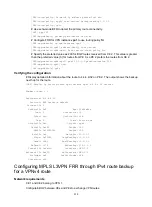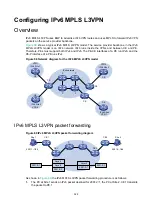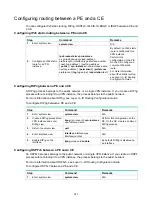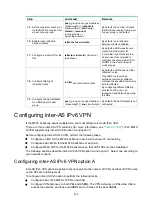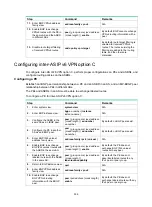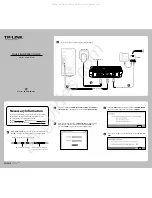
329
Step Command
Remarks
6.
(Optional.) Configure an
external route tag for
redistributed VPN routes.
route-tag
tag-value
By default, if BGP runs within an
MPLS backbone, and the BGP AS
number is not greater than 65535,
the first two octets of the external
route tag are 0xD000. The last two
octets are the local BGP AS
number. If the AS number is
greater than 65535, the external
route tag is 0.
Perform this configuration on the
PE.
7.
(Optional.) Disable setting
the DN bit in OSPFv3 LSAs.
disable-dn-bit-set
By default, when a PE
redistributes BGP routes into
OSPFv3 and creates OSPFv3
LSAs, it sets the DN bit for the
LSAs.
Before using this command, make
sure it does not cause any routing
loops.
Perform this configuration on the
PE.
8.
(Optional.) Ignore the DN bit
in OSPFv3 LSAs.
disable-dn-bit-check
By default, the PE checks the DN
bit in OSPFv3 LSAs.
Before using this command, make
sure it does not cause any routing
loops.
Perform this configuration on the
PE.
9.
(Optional.) Enable the
external route check feature
for OSPFv3 LSAs.
route-tag-check enable
By default, the PE does not check
the external route tag but checks
the DN bit in OSPFv3 LSAs to
avoid routing loops.
This command is only for
backward compatibility with the
old protocol (RFC 4577). If the
device supports the DN bit, use
the DN bit to avoid routing loops.
Perform this configuration on the
PE.
10.
Return to system view.
quit
N/A
11.
Enter interface view.
interface
interface-type
interface-number
N/A
12.
Enable OSPFv3 on the
interface.
ospfv3
process-id
area
area-id
[
instance
instance-id
]
By default, OSPFv3 is disabled on
an interface.
Perform this configuration on the
PE.
Configuring IPv6 IS-IS between a PE and a CE
An IPv6 IS-IS process belongs to the public network or a single VPN instance. If you create an IPv6
IS-IS process without binding it to a VPN instance, the process belongs to the public network.
For more information about IPv6 IS-IS, see
Layer 3—IP Routing Configuration Guide
.
To configure IPv6 IS-IS between a PE and a CE:





